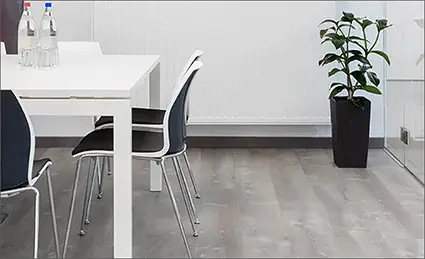What is PVC & Why it is an Excellent Flooring Option?
In the world of modern flooring solutions, PVC has earned a reputation as a versatile, cost-effective, and increasingly sustainable choice. With growing concerns around environmental impact, manufacturers and consumers alike are turning their attention to recycled materials—and PVC (polyvinyl chloride) is at the heart of this shift.

Understanding PVC
PVC stands for polyvinyl chloride, a synthetic plastic polymer that has been in use since the early 20th century. It’s one of the most widely produced plastics in the world, commonly used in construction, healthcare, electronics, and - more recently - flooring.
PVC flooring, often referred to as vinyl flooring, is made by combining PVC resin with various additives that provide durability, flexibility, and design versatility. The result is a product that can closely mimic the look of wood, stone, or ceramic tile, without the associated costs or maintenance requirements.
Key Benefits of PVC as a Flooring Material
PVC flooring is prized for a number of practical advantages, including:
1. Durability
PVC is inherently resistant to moisture, abrasion, stains, and impact. This makes it especially well-suited for high-traffic areas such as offices, retail stores, healthcare facilities, and busy households. Its ability to maintain its appearance over time reduces the need for frequent replacements, contributing to lower long-term costs.
2. Water Resistance
Unlike natural wood or some laminates, PVC flooring is fully water-resistant. It won’t swell, warp, or rot when exposed to moisture, making it ideal for bathrooms, kitchens, and basements.
3. Low Maintenance
PVC floors require minimal upkeep. Regular sweeping and occasional mopping with a mild cleaner are usually sufficient to keep them looking like new. They do not require waxing or polishing.
4. Comfort and Sound Insulation
Many PVC flooring products come with a padded underlayer, offering a softer underfoot feel compared to tile or wood. This also helps in sound absorption, making it a quieter choice for multi-story buildings or apartment complexes.
5. Design Flexibility
Modern manufacturing techniques allow PVC flooring to come in a wide range of colors, patterns, and textures. Whether you want the warm look of oak, the sleek appeal of slate, or a contemporary abstract design, PVC offers virtually limitless options.
The Sustainability Angle: Recycled PVC
While PVC has historically been criticized for its environmental impact, the industry is undergoing a transformation. One of the most promising developments is the increased use of recycled PVC in flooring products.
Recycling PVC not only diverts plastic waste from landfills but also reduces the need for virgin material production—a process that consumes energy and natural resources. Thanks to advanced processing methods, recycled PVC can be repurposed into high-quality flooring that meets the same standards for performance and appearance as new material.
Benefits of Recycled PVC Flooring:
Health and Safety Considerations
Modern PVC flooring products are designed to meet stringent safety standards. Many are certified low-VOC (volatile organic compounds), ensuring they contribute to healthier indoor air quality. Additionally, PVC flooring is non-porous and resistant to microbial growth, making it a hygienic choice for homes and healthcare environments.
Installation and Affordability
Another factor contributing to the popularity of PVC flooring is its ease of installation. Available in tiles, planks, or sheets, many PVC floors come with click-lock or adhesive backing systems that simplify the process. This can reduce labor costs and make it a suitable option for DIY enthusiasts.
In terms of cost, PVC flooring remains one of the most affordable resilient flooring options on the market. When balanced with its long lifespan and minimal maintenance requirements, the overall value proposition is hard to beat.
A Smart Choice for the Future
As environmental awareness continues to shape consumer behavior and manufacturing practices, PVC flooring—especially those made from recycled materials—offers a compelling solution. It blends functionality, style, and sustainability in a way few other flooring types can match.
By choosing PVC flooring made from recycled plastic, consumers are not only investing in a high-performing product but also contributing to a more circular, less wasteful economy. With continued innovation and increased access to recycled materials, the future of PVC flooring looks both bright and green.
